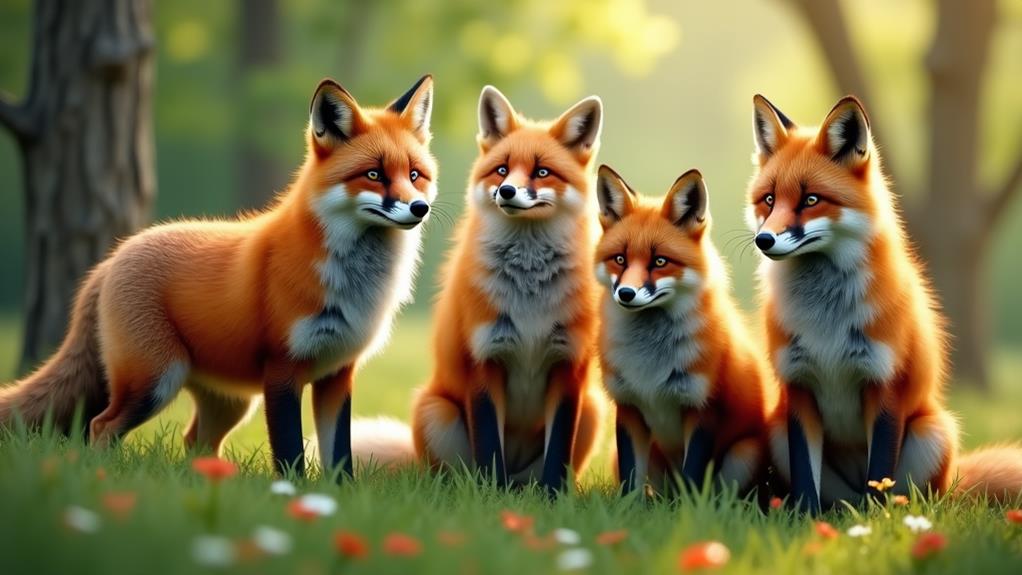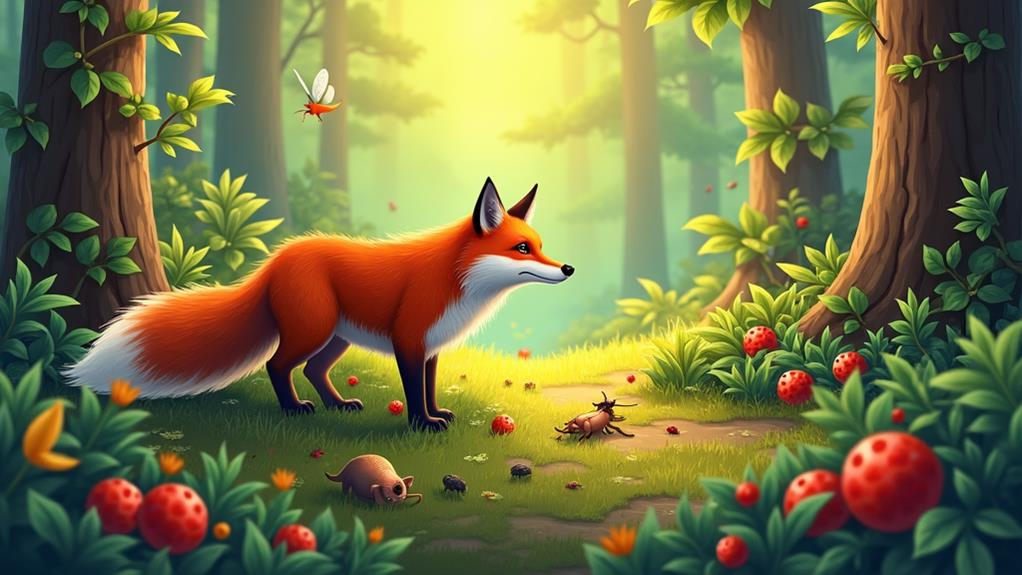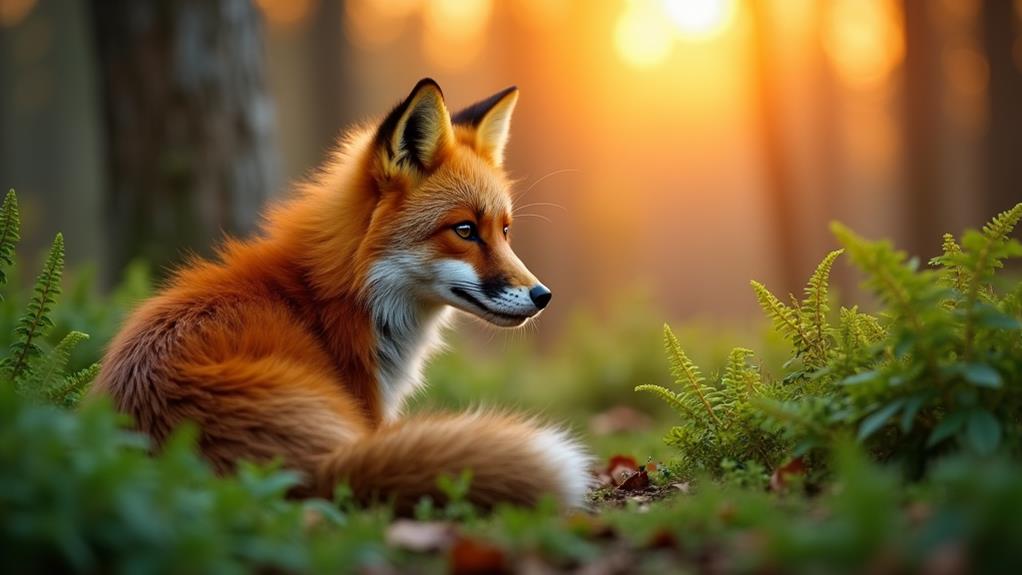Did you know red foxes come in various colors beyond just rusty red? You might spot silver, black, or even a charming pink champagne fox! They're super adaptable, thriving in everything from urban areas to deep forests, and can hear small critters underground from over 100 feet away. These clever hunters use a pouncing technique called "mousing." Social beings, red foxes often stick together in family groups, where dad pitches in with food. Finally, while many foxes thrive, some, like the Sierra Nevada red fox, are critically endangered. Curious to uncover more about these enchanting foxes?
Contents
Color Variations of Red Foxes

Exploring the vibrant world of red foxes reveals a stunning variety of color morphs that go far beyond the typical rusty red. You might be surprised to learn that these clever creatures don't just come in one color. There are silver and black foxes that have established their presence mainly in North America, showcasing how adaptable red foxes can be in various environments and notable species of foxes exist worldwide.
If you love unique looks, you'll adore the marble fox, which sports a striking white coat with beautiful grey or black streaks. It's like they just walked out of a fashion magazine!
Then there's the pink champagne fox with its delightful peachy-white fur and adorable pink nose that'll make your heart melt. Don't forget about the cross fox, which features a blend of red fur and eye-catching black patches.
What's really amazing is that color variations can occur within the same litter. Imagine siblings looking like a mixed bag of colors! This diversity not only adds to their charm but also highlights nature's creativity.
Red foxes truly embrace their colorful identities, showing us the beauty of being different.
Red Foxes' Unique Adaptations
Adapting to their environments with impressive versatility, red foxes showcase a range of unique features that enhance their survival skills. They thrive in a variety of habitats, from urban parks to dense forests, allowing them to exploit different environments for food and shelter, which is evident in their habitat diversity and preferences.
These clever creatures possess exceptional hearing, allowing them to pick up on the slightest sounds of rodents scurrying underground. Imagine having ears that can hear your favorite snacks moving—how cool is that?
Moreover, red foxes harness the Earth's magnetic field, giving them a unique ability to locate their prey, making their hunting accurate and efficient. When night falls, they don't hold back. Thanks to a special layer in their eyes called the tapetum lucidum, they've fantastic night vision, which lets them roam and hunt effectively in the dark.
And let's not forget about their athleticism! Red foxes can leap over six-foot fences and dash away at speeds of up to 30 mph—like furry little ninjas on a mission.
Their stealth is further enhanced by the fur that covers their footpads, allowing them to walk softly through diverse environments. With these adaptations, red foxes continue to impress us with their remarkable skills in the wild!
Diet Diversity and Hunting Skills

Red foxes' remarkable adaptability extends to their diet, which is as diverse as their habitats. These clever critters can thrive in various environments by enjoying a wide array of foods. Just imagine what they might munch on:
- Small mammals: like mice, voles, and rabbits.
- Birds: from sparrows to songbirds, they've got it covered.
- Fruits: berries and apples, perfect for a snack.
- Insects: crunchy crickets are always a tasty treat.
Interestingly, red foxes are often found in urban areas as they scavenge for food, highlighting their ability to thrive alongside humans. Their superb hunting skills help them catch dinner with ease.
Thanks to their extraordinary hearing, red foxes can detect rodents underground from up to 100 feet away! When it's time to hunt, they utilize a technique called "mousing," where they stalk their prey with utmost stealth, then pounce like a furry ninja.
Plus, when food's plentiful, they don't forget to cache food, storing extras for leaner days. This ability to adjust their foraging strategies based on what's available showcases their remarkable adaptability.
Social Structures and Family Life
In the intricate world of foxes, social structures play an essential role in their family life. Red foxes often live in family groups, which consist of a breeding pair and their adorable offspring, known as kits. This tight-knit unit fosters cooperation, especially during the breeding season.
With remarkable adaptability, these foxes can thrive in various environments, including urban settings, which often leads to larger populations forming in areas where food is readily available. Dads chip in by bringing food for their partners, ensuring the little ones are well taken care of.
You might laugh to learn that playful behavior is a hallmark of these young kits. As they tumble and tussle, they're not just having fun; they're honing important survival skills that prepare them for the big, wild world outside.
Communication is key here, too. Red foxes use a mix of vocalizations, body language, and scent marking to establish their territory and maintain strong family bonds.
These kits typically stay with their parents for about seven months. During this time, they learn crucial hunting techniques, getting a crash course in what it takes to thrive on their own.
After their lesson, the happy teens set off to find their own territories, ready to take on the world, just like their parents did. Isn't nature fascinating?
Conservation and Endangered Subspecies

Foxes are fascinating creatures, but not all populations are thriving. Some red fox subspecies are struggling and need our help. Their remarkable adaptability allows them to thrive in various environments, yet habitat loss poses a significant threat to certain populations.
Here's a look at why conservation is so important for these beautiful animals:
- The Sierra Nevada red fox is critically endangered, with only about 50 left in the wild due to habitat loss and fragmentation.
- The Korean red fox faces threats like habitat destruction and poaching, which have drastically reduced its numbers.
- Overall, red foxes globally are classified as Least Concern, but some local threats can be serious.
- Conservation programs focus on preserving habitats, reducing human-wildlife conflict, and educating people about their ecological importance, as red foxes play a vital role in maintaining ecosystem balance.
Final Thoughts
So there you have it—red foxes are more than just clever little critters darting through the woods. With their vibrant colors, amazing adaptability, and impressive hunting skills, they've got quite the story to tell. Their social lives are like a family drama you'd binge-watch on a rainy day! It's essential we protect these fascinating creatures and their habitats. After all, just like in a good tale, every character matters, and the red fox is no exception!














